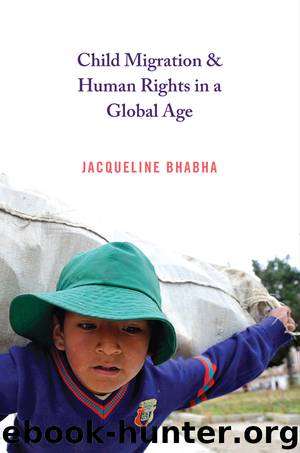Child Migration and Human Rights in a Global Age by Bhabha Jacqueline

Author:Bhabha, Jacqueline
Language: eng
Format: epub
Publisher: Princeton University Press
Published: 2014-04-10T04:00:00+00:00
PART III
Demanding a Future: Child Migration for Survival
CHAPTER 6
David and Goliath: Children’s Unequal Battle for Refugee Protection
If you would deport children without knowing why they would make the journey to this country, you may be deporting them to death, when all they were looking for was life.1
Introduction and Background
Edgar Chocoy made two international journeys in his short life. He chose the first himself at the age of fourteen—an overland solo migration from Guatemala, via Mexico, to California. His purpose was to find what the UN Convention on the Rights of the Child mandates for each child—“a family environment … an atmosphere of happiness, love and understanding.”2 Edgar sought to leave behind the dangers and hardships of the street and gang life in Guatemala that he had been forced into after his mother abandoned him as an infant. Hoping to find her, Edgar made his way to Los Angeles and eventually reunited with his mother. At the age of sixteen, he applied for asylum on the basis of the persecution he feared from the street gang he had turned his back on.3 The US government chose Edgar’s second trip: a forced removal from Los Angeles back to Guatemala following denial of his asylum application. The US government had advance notice of the intensity of Edgar’s fear of return and of the risks facing him in Guatemala: after being informed that his asylum claim had been refused and that he was going to be sent back, Edgar attempted to hang himself with his own shoelaces while in detention. Nevertheless he was returned to the place he fled and the people he feared. Seventeen days after his removal from the United States, members of Edgar’s former gang murdered him.4
Edgar’s first journey was prompted by his need for international refugee protection, and by considerations of his own “best interest.” A fundamental tenet of international law is that the best interests of children be a primary consideration in all actions affecting them.5 Normally, best-interest calculations (as indeed most plans affecting children’s lives) are made by adults on the behalf of children. In this case the best-interest judgment was exercised by the child himself, without adult intervention or oversight. A “left-behind child” trying to make the best of his limited options, Edgar chose migration followed by an asylum application over continued danger and destitution at home. Edgar’s second journey was decided by US government immigration officials and an immigration court judge, but with no regard for his “best interest.” The child exercised his agency to secure protection and the possibility of a viable life; the “responsible” adults intervened and sent him to his death.
The circumstances of Edgar’s case are tragic and increasingly familiar. Latin American children and adolescents continue to seek US asylum due to fears of gang violence and retaliation,6 yet the overwhelming majority are rejected and returned to the danger they fled. Some die; many live in hiding.7 This state-induced return migration prompts fundamental questions about state complicity in serious human-rights violations against children. These are the questions that first led me to investigate this area of law.
Download
This site does not store any files on its server. We only index and link to content provided by other sites. Please contact the content providers to delete copyright contents if any and email us, we'll remove relevant links or contents immediately.
Nolo's Essential Guide to Divorce by Emily Doskow(1348)
The Family Law by Benjamin Law(1345)
A Long Way Gone: Memoirs of a Boy Soldier by Ishmael Beah(1319)
Organised Sexual Abuse by Salter Michael(1232)
A Woman to Blame by Nell McCafferty(1203)
1916 in 1966 by Mary E. Daly(1199)
Kid Gloves by Adam Mars-Jones(1154)
Babies of Technology by Mary Ann Mason(1136)
I Am Nobody: Confronting the Sexually Abusive Coach who Stole My Life by Greg Gilhooly(1114)
Family Law: A Very Short Introduction by Jonathan Herring(1085)
If You're in My Office, It's Already Too Late by James J. Sexton(1056)
The Little Book of Restorative Justice for Older Adults by Julie Friesen(1040)
Buying a Bride by Zug Marcia A.;(1038)
The Slave Across the Street by Theresa L. Flores(1034)
I Am Nujood, Age 10 and Divorced by Nujood Ali & Delphine Minoui & Linda Coverdale(1033)
Loving by Sheryll Cashin(1021)
The Divorce Hacker's Guide to Untying the Knot by Ann E. Grant(1020)
Triple Talaq by Salman Khurshid(987)
I Am Nujood, Age 10 and Divorced by Ali Nujood(986)
